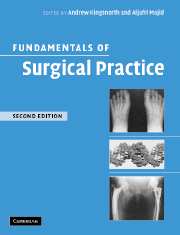Book contents
- Frontmatter
- Contents
- Preface
- Contributors
- 1 Preoperative management
- 2 Principles of anaesthesia
- 3 Postoperative management
- 4 Nutritional support
- 5 Surgical sepsis: prevention and therapy
- 6 Surgical techniques and technology
- 7 Trauma: general principles of management
- 8 Intensive care
- 9 Principles of cancer management
- 10 Ethics, legal aspects and assessment of effectiveness
- 11 Haemopoietic and lymphoreticular systems: anatomy, physiology and pathology
- 12 Upper gastrointestinal surgery
- 13 Lower gastrointestinal surgery
- 14 Hernia management
- 15 Vascular surgery
- 16 Endocrine surgery
- 17 The breast
- 18 Thoracic surgery
- 19 Genitourinary system
- 20 Head and neck
- 21 The central nervous system
- 22 Musculoskeletal system
- 23 Paediatric surgery
- Index
19 - Genitourinary system
Published online by Cambridge University Press: 15 December 2009
- Frontmatter
- Contents
- Preface
- Contributors
- 1 Preoperative management
- 2 Principles of anaesthesia
- 3 Postoperative management
- 4 Nutritional support
- 5 Surgical sepsis: prevention and therapy
- 6 Surgical techniques and technology
- 7 Trauma: general principles of management
- 8 Intensive care
- 9 Principles of cancer management
- 10 Ethics, legal aspects and assessment of effectiveness
- 11 Haemopoietic and lymphoreticular systems: anatomy, physiology and pathology
- 12 Upper gastrointestinal surgery
- 13 Lower gastrointestinal surgery
- 14 Hernia management
- 15 Vascular surgery
- 16 Endocrine surgery
- 17 The breast
- 18 Thoracic surgery
- 19 Genitourinary system
- 20 Head and neck
- 21 The central nervous system
- 22 Musculoskeletal system
- 23 Paediatric surgery
- Index
Summary
Urology is the study of diseases of the urinary tract and the male reproductive system. Some of the earliest operations described are urological procedures and the ancient Egyptians are known to have performed surgical castration and cystolithotomy (open removal of bladder stones).
Functional disorders of micturition may lead to urine incontinence or urine retention. Metabolic abnormalities result in renal stone disease. Developmental abnormalities are seen in the neonate and the developing child (see also Chapter 21). Urological cancers are common and their management can affect continence, fertility and, of course, quality of life (QoL).
Despite the numerous diseases that can affect the urinary tract, the presenting symptoms are few, making accurate diagnosis dependent on the careful imaging of structural abnormalities as well as a functional assessment of voiding and renal function.
ANATOMY AND DEVELOPMENTAL ANOMALIES
Kidney
Gross anatomy
The adult kidney, a paired organ, is 11-cm long, weighs 150 g and lies on the diaphragm with the psoas, quadratus lumborum and transversus abdominis muscles from medical to lateral on the lower half.
Anteriorly, the right kidney is covered on its medial aspect by the second part of the duodenum and the liver overlying the upper pole and hepatic flexure of the colon covering the lower part of the anterolateral aspect.
- Type
- Chapter
- Information
- Fundamentals of Surgical Practice , pp. 369 - 390Publisher: Cambridge University PressPrint publication year: 2006

